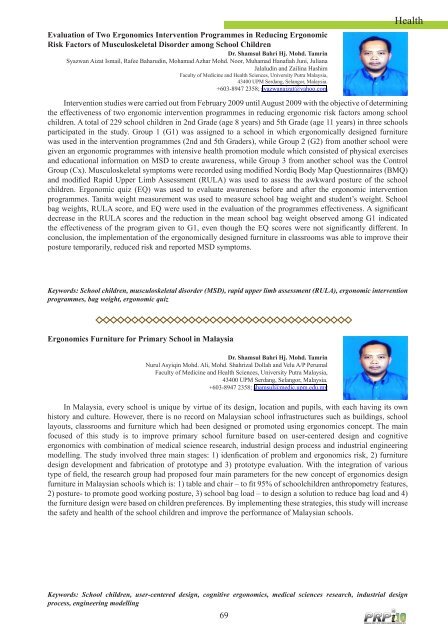BUKU ABSTRAK - Universiti Putra Malaysia
BUKU ABSTRAK - Universiti Putra Malaysia
BUKU ABSTRAK - Universiti Putra Malaysia
You also want an ePaper? Increase the reach of your titles
YUMPU automatically turns print PDFs into web optimized ePapers that Google loves.
Evaluation of Two Ergonomics Intervention Programmes in Reducing Ergonomic<br />
Risk Factors of Musculoskeletal Disorder among School Children<br />
Dr. Shamsul Bahri Hj. Mohd. Tamrin<br />
Syazwan Aizat Ismail, Rafee Baharudin, Mohamad Azhar Mohd. Noor, Muhamad Hanafiah Juni, Juliana<br />
Jalaludin and Zailina Hashim<br />
Faculty of Medicine and Health Sciences, University <strong>Putra</strong> <strong>Malaysia</strong>,<br />
43400 UPM Serdang, Selangor, <strong>Malaysia</strong>.<br />
+603-8947 2358; syazwanaizat@yahoo.com<br />
Intervention studies were carried out from February 2009 until August 2009 with the objective of determining<br />
the effectiveness of two ergonomic intervention programmes in reducing ergonomic risk factors among school<br />
children. A total of 229 school children in 2nd Grade (age 8 years) and 5th Grade (age 11 years) in three schools<br />
participated in the study. Group 1 (G1) was assigned to a school in which ergonomically designed furniture<br />
was used in the intervention programmes (2nd and 5th Graders), while Group 2 (G2) from another school were<br />
given an ergonomic programmes with intensive health promotion module which consisted of physical exercises<br />
and educational information on MSD to create awareness, while Group 3 from another school was the Control<br />
Group (Cx). Musculoskeletal symptoms were recorded using modified Nordiq Body Map Questionnaires (BMQ)<br />
and modified Rapid Upper Limb Assessment (RULA) was used to assess the awkward posture of the school<br />
children. Ergonomic quiz (EQ) was used to evaluate awareness before and after the ergonomic intervention<br />
programmes. Tanita weight measurement was used to measure school bag weight and student’s weight. School<br />
bag weights, RULA score, and EQ were used in the evaluation of the programmes effectiveness. A significant<br />
decrease in the RULA scores and the reduction in the mean school bag weight observed among G1 indicated<br />
the effectiveness of the program given to G1, even though the EQ scores were not significantly different. In<br />
conclusion, the implementation of the ergonomically designed furniture in classrooms was able to improve their<br />
posture temporarily, reduced risk and reported MSD symptoms.<br />
Keywords: School children, musculoskeletal disorder (MSD), rapid upper limb assessment (RULA), ergonomic intervention<br />
programmes, bag weight, ergonomic quiz<br />
Ergonomics Furniture for Primary School in <strong>Malaysia</strong><br />
Dr. Shamsul Bahri Hj. Mohd. Tamrin<br />
Nurul Asyiqin Mohd. Ali, Mohd. Shahrizal Dollah and Velu A/P Perumal<br />
Faculty of Medicine and Health Sciences, University <strong>Putra</strong> <strong>Malaysia</strong>,<br />
43400 UPM Serdang, Selangor, <strong>Malaysia</strong>.<br />
+603-8947 2358; shamsul@medic.upm.edu.my<br />
In <strong>Malaysia</strong>, every school is unique by virtue of its design, location and pupils, with each having its own<br />
history and culture. However, there is no record on <strong>Malaysia</strong>n school infrastructures such as buildings, school<br />
layouts, classrooms and furniture which had been designed or promoted using ergonomics concept. The main<br />
focused of this study is to improve primary school furniture based on user-centered design and cognitive<br />
ergonomics with combination of medical science research, industrial design process and industrial engineering<br />
modelling. The study involved three main stages: 1) idenfication of problem and ergonomics risk, 2) furniture<br />
design development and fabrication of prototype and 3) prototype evaluation. With the integration of various<br />
type of field, the research group had proposed four main parameters for the new concept of ergonomics design<br />
furniture in <strong>Malaysia</strong>n schools which is: 1) table and chair – to fit 95% of schoolchildren anthropometry features,<br />
2) posture- to promote good working posture, 3) school bag load – to design a solution to reduce bag load and 4)<br />
the furniture design were based on children preferences. By implementing these strategies, this study will increase<br />
the safety and health of the school children and improve the performance of <strong>Malaysia</strong>n schools.<br />
Keywords: School children, user-centered design, cognitive ergonomics, medical sciences research, industrial design<br />
process, engineering modelling<br />
69<br />
Health



